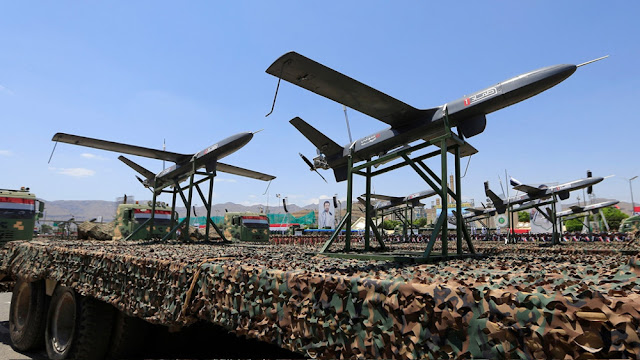In a bold escalation of regional tensions, Yemen’s armed forces, aligned with the Ansarullah movement, announced a series of coordinated missile and drone strikes targeting Israeli-occupied territories. The operations, described as retaliatory measures in support of the Palestinian cause, were detailed in a statement broadcast by Yemen’s al-Masirah TV. Brigadier General Yahya Saree, the spokesperson for Yemen’s armed forces, provided a comprehensive overview of the military actions, emphasizing their precision, success, and underlying motivations. The strikes, which included the use of a supersonic missile and multiple drones, were aimed at military installations in the occupied Negev region and near Eilat, signaling Yemen’s growing military assertiveness and its commitment to confronting Israeli actions in both Gaza and Yemen.
The statement comes amid heightened regional conflict, following a deadly wave of Israeli airstrikes on Yemen’s capital, Sana’a, and the northern province of al-Jawf, which left dozens of civilians dead and injured. The Yemeni operations are framed as a direct response to these attacks and a broader show of solidarity with the Palestinian people, who have faced prolonged Israeli military actions in Gaza. The developments underscore the deepening entanglement of regional actors in the Israeli-Palestinian conflict, with Yemen emerging as a significant player willing to challenge Israel directly through military means.
Details of the Yemeni Military Operations
According to Brigadier General Yahya Saree, the Yemeni armed forces executed a multi-pronged assault on Israeli targets on Thursday, employing advanced weaponry to strike strategic locations in the occupied territories. The centerpiece of the operation was the deployment of a supersonic missile, dubbed “Palestine 2,” which targeted a military installation in the Negev region. Saree described the missile strike as highly successful, noting that it forced a significant number of Israeli settlers to seek shelter, disrupting normal activities in the targeted area. The use of a supersonic missile represents a technological leap for Yemen’s armed forces, showcasing their growing capability to project power far beyond their borders.
In addition to the missile strike, Yemen’s drone units conducted two separate attacks. The first involved the deployment of two drones targeting Ramon Airport, located near the city of Eilat (referred to as Umm al-Rashrash in the Yemeni statement). The second strike utilized a single drone to hit another military target in the Negev region. Saree emphasized that both drone operations achieved their objectives, underscoring the precision and coordination of Yemen’s military strategy. While specific details about the damage caused or the exact nature of the targets were not disclosed, the strikes were presented as a clear message to Israel that Yemen possesses both the will and the means to retaliate against perceived aggression.
The choice of targets—military installations and an airport—suggests a deliberate effort to disrupt Israel’s military infrastructure while minimizing civilian casualties. However, the psychological impact of the strikes was evident, as the reported rush to shelters among settlers indicates a disruption of daily life in the affected areas. The operations also highlight Yemen’s strategic focus on high-value targets, such as airports, which serve both civilian and military purposes and are critical to Israel’s regional dominance.
Context and Motivation Behind the Strikes
The Yemeni armed forces framed their attacks as a direct response to two key grievances: Israel’s ongoing military operations in Gaza and its recent airstrikes on Yemeni soil. The conflict in Gaza, which has seen repeated Israeli offensives targeting Palestinian civilians and infrastructure, has long been a rallying point for Yemen’s Ansarullah movement. The group, also known as the Houthis, has consistently expressed solidarity with the Palestinian cause, viewing it as a central pillar of their ideological and political agenda. By launching attacks on Israeli territory, Yemen’s armed forces aim to pressure Israel into halting its actions in Gaza, while also asserting their role as a regional actor capable of influencing the broader conflict.
The immediate trigger for the strikes, however, appears to be Israel’s airstrikes on Yemen, which occurred just a day earlier. On Wednesday, Israeli warplanes targeted civilian and residential areas in Sana’a and al-Jawf, killing at least 36 people and wounding over 130 others, according to Yemen’s Health Ministry. The raids struck multiple locations, including homes in Sana’a’s al-Tahrir neighborhood, a medical facility on 60th Street in the southwest of the city, and a government compound in al-Hazm, the provincial capital of al-Jawf. The attacks also reportedly targeted the headquarters of two Yemeni newspapers, 26 September and al-Yemen, resulting in the deaths and injuries of several journalists.
The scale and intensity of the Israeli airstrikes on Yemen represent a significant escalation in the conflict between the two nations. While Israel has not officially commented on the reasons for the strikes, they are widely seen as a response to Yemen’s increasing military actions against Israeli interests, including previous missile and drone attacks on Israeli ships in the Red Sea and other targets in the occupied territories. The targeting of civilian infrastructure, including residential areas and media outlets, has drawn widespread condemnation in Yemen and further inflamed anti-Israel sentiment.
Brigadier General Saree’s statement explicitly linked the Yemeni strikes to these Israeli actions, describing them as “retaliation for Israeli aggression against our territory.” He emphasized that Yemen’s armed forces would continue to support the Palestinian people through military means, signaling that the recent operations are part of a broader strategy to counter Israel’s regional dominance. The use of the term “Palestine 2” for the supersonic missile further underscores the symbolic connection between Yemen’s actions and the Palestinian struggle, framing the strikes as part of a larger resistance against Israeli occupation.
Ansarullah’s Broader Threats and Rhetoric
The Yemeni operations were accompanied by strong rhetoric from senior Ansarullah officials, who vowed to escalate their retaliatory actions against Israel. Abdullah al-Ahnumi, the media relations director of Ansarullah, issued a stark warning to Israel, stating that Yemen’s military operations would ensure that “no place is safe” for the Israeli regime or its settlers in the occupied territories. Al-Ahnumi specifically referenced the Israeli airstrikes on Tahrir Square in Sana’a, describing them as a “horrific crime” that would not go unanswered. He promised that Yemen’s retaliatory strikes would target a wide range of Israeli assets, including military bases, airports, settlers’ gatherings, and other sensitive sites.
“Our response will be to target Zionist gatherings, wherever they are present, whether in settlements, airport lounges, or any other place,” al-Ahnumi declared. He emphasized the value of Yemeni lives, stating, “The enemy must know that the blood of our people is precious and that the shedding of this will trigger stronger reciprocal responses and retaliations.” This rhetoric reflects Ansarullah’s broader strategy of projecting strength and resilience in the face of Israeli military superiority, while also rallying domestic and regional support by framing their actions as a defense of both Yemeni and Palestinian dignity.
Al-Ahnumi’s statements also highlight the evolving nature of Yemen’s military strategy. By threatening to target a wide range of Israeli assets, including civilian gatherings, Ansarullah is signaling its intent to escalate the conflict and impose a higher cost on Israel for its actions. This approach mirrors the group’s tactics in other regional conflicts, such as its attacks on Saudi-led coalition targets during Yemen’s ongoing civil war. However, the direct targeting of Israeli territory represents a significant expansion of Ansarullah’s operational scope, raising questions about the group’s military capabilities and its ability to sustain such operations in the face of potential Israeli retaliation.
The Humanitarian Impact of Israeli Airstrikes on Yemen
The Israeli airstrikes on Sana’a and al-Jawf have had a devastating impact on Yemen’s already beleaguered civilian population. The country, which has been embroiled in a decade-long civil war and faces one of the world’s worst humanitarian crises, is particularly vulnerable to such attacks. Yemen’s Health Ministry reported that the strikes targeted civilian infrastructure, including residential neighborhoods and a medical facility, exacerbating the suffering of ordinary Yemenis. The attack on the al-Tahrir neighborhood in Sana’a, a densely populated area, caused significant destruction, with civil defense teams working tirelessly to extinguish fires and rescue survivors trapped in the rubble.
The targeting of a medical facility on 60th Street is particularly egregious, as it underscores the indiscriminate nature of the Israeli strikes. Hospitals and medical centers are protected under international humanitarian law, and their destruction further undermines Yemen’s already strained healthcare system. Similarly, the attack on the government compound in al-Hazm, al-Jawf, highlights Israel’s willingness to target symbols of Yemeni sovereignty, further escalating tensions between the two nations.
The strikes on the headquarters of the 26 September and al-Yemen newspapers represent an assault on Yemen’s media infrastructure, raising concerns about press freedom and the targeting of journalists. According to a senior Yemeni source speaking to al-Mayadeen television, several journalists were killed or injured in the attacks, further compounding the human toll. The targeting of media outlets suggests an intent to silence voices critical of Israel’s actions, a tactic that has drawn condemnation from press freedom advocates and human rights organizations.
The humanitarian consequences of the Israeli airstrikes are likely to have far-reaching implications for Yemen’s already dire situation. The country’s infrastructure, including its healthcare system, water supply, and food distribution networks, has been decimated by years of conflict, blockade, and economic collapse. The additional strain caused by the Israeli strikes risks pushing Yemen further into crisis, with potential consequences for regional stability and the broader Middle East.
Regional and International Implications
The Yemeni strikes on Israeli territory and the preceding Israeli airstrikes on Yemen mark a significant escalation in the regional conflict, with potential implications for the broader Middle East. Yemen’s emergence as a direct military actor against Israel challenges the traditional dynamics of the Israeli-Palestinian conflict, which has historically been dominated by state and non-state actors in closer proximity to Israel, such as Hezbollah in Lebanon and Hamas in Gaza. By launching long-range missile and drone attacks, Yemen is asserting its role as a key player in the so-called “Axis of Resistance,” a loose coalition of anti-Israel groups backed by Iran.
The involvement of Yemen in the conflict also raises questions about Iran’s role, given its longstanding support for Ansarullah. While there is no direct evidence that Iran orchestrated the Yemeni strikes, the use of advanced weaponry, such as the “Palestine 2” supersonic missile, suggests that Yemen may have benefited from Iranian technological assistance. This dynamic is likely to heighten tensions between Israel and Iran, with the latter facing accusations of fueling regional instability through its support for proxy groups.
For Israel, the Yemeni strikes represent a new front in its ongoing conflicts with regional adversaries. The ability of Yemen’s armed forces to strike deep into Israeli territory, even if the damage is limited, underscores the vulnerability of Israel’s air defense systems to asymmetric threats. The psychological impact of the strikes, particularly the disruption caused to settlers, could also fuel domestic pressure on the Israeli government to respond forcefully, potentially leading to further escalation.
Internationally, the Yemeni-Israeli confrontation is likely to draw attention to the broader Israeli-Palestinian conflict and the role of external actors in perpetuating or mitigating it. The United States, Israel’s primary ally, has so far remained silent on the Yemeni strikes, but it is likely to face pressure to support Israel’s right to self-defense while also navigating the complex dynamics of its relationship with Yemen and other regional actors. The United Nations and other international bodies may also face calls to address the humanitarian consequences of the Israeli airstrikes on Yemen and to mediate a de-escalation of tensions.
Yemen’s Military Capabilities and Strategic Objectives
The successful execution of missile and drone strikes on Israeli territory highlights the significant advancements in Yemen’s military capabilities. Despite the country’s economic and humanitarian challenges, Ansarullah has invested heavily in developing its missile and drone programs, leveraging relatively low-cost technologies to project power across vast distances. The “Palestine 2” supersonic missile, in particular, represents a significant achievement, as such weapons require advanced engineering and guidance systems to achieve precision and evade air defenses.
The use of drones in the attacks further underscores Yemen’s growing expertise in unmanned aerial systems. Drones are a cost-effective means of conducting asymmetric warfare, allowing Yemen to target high-value assets without risking significant personnel or resources. The strikes on Ramon Airport and the Negev region demonstrate Yemen’s ability to coordinate complex operations involving multiple platforms, a capability that was previously associated primarily with state actors or more established non-state groups like Hezbollah.
Strategically, Yemen’s actions serve multiple objectives. First, they aim to deter further Israeli aggression by demonstrating the costs of targeting Yemeni territory. Second, they bolster Ansarullah’s domestic and regional legitimacy by positioning the group as a champion of the Palestinian cause and a defender of Yemeni sovereignty. Third, the strikes contribute to the broader narrative of resistance against Israel and its allies, aligning Yemen with other anti-Israel actors in the region.
However, the escalation also carries significant risks for Yemen. Israel’s military superiority, combined with its history of responding forcefully to attacks, raises the possibility of further airstrikes or other forms of retaliation. Such actions could exacerbate Yemen’s humanitarian crisis and strain Ansarullah’s resources, particularly if the group is forced to divert attention from its domestic challenges to sustain a prolonged confrontation with Israel.
Conclusion
The Yemeni missile and drone strikes on Israeli-occupied territories mark a significant escalation in the regional conflict, driven by Yemen’s commitment to the Palestinian cause and its response to Israeli airstrikes on its soil. The operations, which involved the use of a supersonic missile and multiple drones, demonstrate Yemen’s growing military capabilities and its willingness to confront Israel directly. The Israeli airstrikes on Sana’a and al-Jawf, which killed and injured dozens of civilians, have further inflamed tensions, prompting strong retaliatory rhetoric from Ansarullah leaders.
The conflict between Yemen and Israel reflects the broader dynamics of the Middle East, where local grievances, ideological commitments, and regional rivalries intersect to create a volatile and unpredictable environment. As Yemen continues to assert its role in the Israeli-Palestinian conflict, the risk of further escalation looms large, with potential consequences for regional stability and the humanitarian situation in Yemen. The international community faces the challenge of addressing the root causes of the conflict while mitigating the immediate humanitarian impact of the ongoing violence.






